For almost every e-commerce website, providing an interactive and user-friendly shopping experience is a significant way to boost your customer satisfaction rates and sales figures. There are many ways to do this, but a WooCommerce price calculator can make the difference where you need to build complex pricing configurations for your products and services.
In this article, we’ll explore what a WooCommerce price calculator is, why you might need one, and more. Towards the end, you’ll learn how to build one for your WooCommerce store using Advanced Product Fields for WooCommerce plugin.
What a WooCommerce price calculator is (and what it can bring to your site)
The following situation will be typical for many online stores, but imagine you run a print shop for various office supplies. Customers will often want to order custom business cards, but the price can differ depending on a multitude of factors. For instance, they may want the best quality paper, top of the line finishing, or a custom quantity.
Without a price calculator, the customer would likely need to contact you for a quote. This isn’t the worst situation to be in, as you can deliver a personalized ‘human’ service to that customer. However, if they don’t have the time or the inclination to contact you, they can lose interest—and you lose out on a sale.
This is where a WooCommerce price calculator comes in. It’s a dynamic tool that you integrate into your site’s product pages. It lets customers input specific parameters or choices related to your product, which the calculator will then compute to display a total price.

While a WooCommerce price calculator won’t suit every site, it’s useful for products or services that vary in price based on customization, quantity, or specific measurements.
By implementing a price calculator, you’re not just providing a price—you offer an interactive experience that will engage customers and help them to make informed purchasing decisions.
Why your WooCommerce website would benefit from a price calculator
Adding a WooCommerce price calculator can transform your customer’s shopping experience and streamline the way you do business. There are lots of advantages in implementing a dynamic pricing tool:
- Enhanced user experience. You can provide instant pricing information, which eliminates the need for customers to contact you for quotes. This immediacy can improve user satisfaction and increase the likelihood of completing a purchase.
- Increased conversion rates. By letting customers see how different choices affect the final price, you empower them to make informed decisions. This transparency can also lead to higher conversion rates.
- It saves time. Automated pricing reduces the time you spend on manual quotes, which lets you focus on other aspects of your business.
- Flexibility for complex products. For products with multiple variables affecting the price, a calculator can handle complex pricing structures that would be difficult to represent usually.
- Customization. Price calculators can offer a high degree of product customization, which can set your store apart from the competition.
That flexibility also extends to application. In the next section, we’ll look at some situations where a WooCommerce pricing calculator can benefit your store.
Popular examples of price calculators in WooCommerce
You can use a price calculator across a wide range of products and services. Understanding when and where to use one can help you envision how this might benefit your specific WooCommerce store.
Let’s explore three common scenarios where a price calculator can be particularly beneficial.
1. Measurement-based pricing
Measurement-based pricing is ideal for products where the price is determined by size or area. This type of calculator is commonly used in industries such as home improvement, textiles, and custom manufacturing.
Measurement-based pricing lets customers input specific dimensions. The calculator will typically offer input fields for measurements (such as width and height), a base price per unit of measurement, and a formula to calculate the total price.
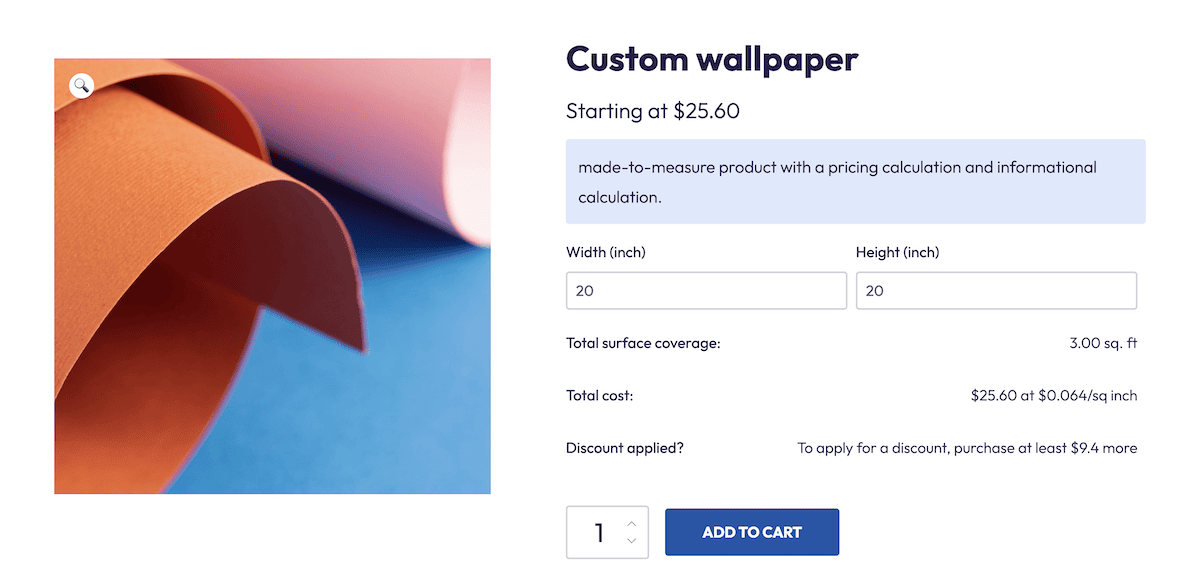
Here, a customer can input the dimensions of their space, and the calculator will provide a total surface coverage, cost, and discount saving. This not only saves time for both the customer and the business, but also reduces the likelihood of ordering errors.
Products such as custom wallpaper, flooring materials, fabric for curtains or upholstery, or custom-cut glass and mirrors will all benefit from this type of pricing model. This is because it provides greater accuracy for custom sizes without the need for manual quotes.
We cover how to build a measurement-based price calculator elsewhere on the blog, so check that out to see an in-depth look at this particular application.
2. Service-based pricing
A service-based price calculator is essential where you need to offer variable totals based on specific client needs or project requirements. Cleaning services, web design, event planning, or moving services all use this type of pricing.
The calculator lets clients get an estimate for services based on their specific requirements. It can help them understand the costs upfront, which reduces the need for back-and-forth communication. What’s more, it streamlines the whole quote process.
Home decor businesses can also leverage a price calculator. For instance, the Finnish Vekkoremontti site intakes lots of information about floor areas, paint colors, wallpaper options, and more to provide a quote for building renovation:
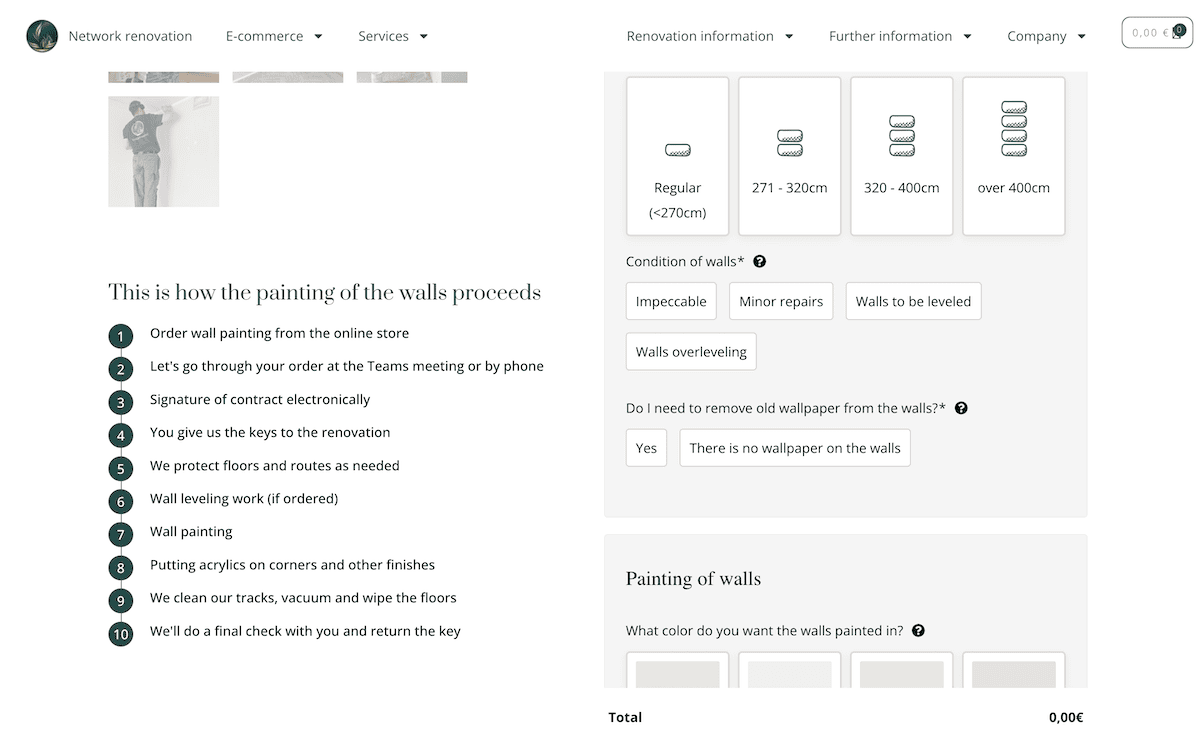
This pricing style will often need a complex set of input fields and conditional logic. For instance, you could ask for a number of required rooms, use an event duration time frame, or set base prices for different service levels.
3. Custom product configuration
Custom product configuration calculators are perfect if you offer personalized products where each option affects the final price. It lets customers build their ideal product by selecting various options.
You’ll often find multiple selection fields for various product options, base prices for each option, and complex pricing rules to handle interactions between different choices. The price usually updates in real-time.
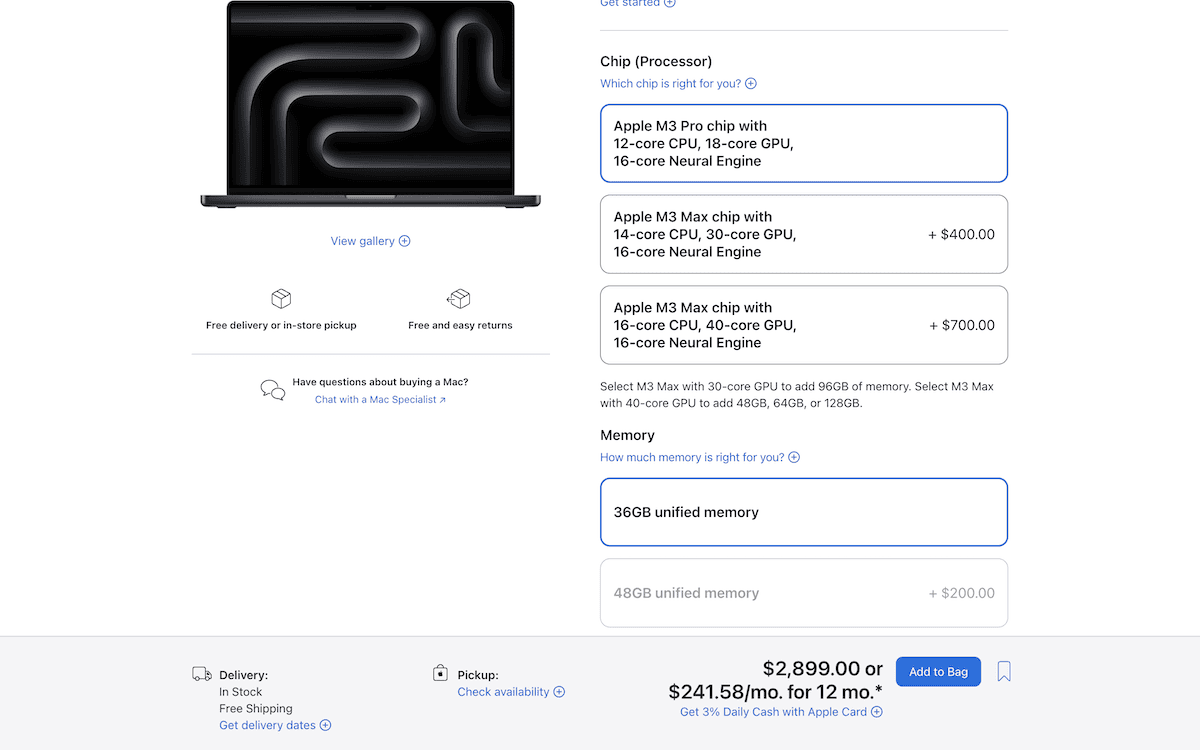
While computing is a clear use case for this type of pricing model, you may even see a similar calculator for jewelry stores, furniture outlets, or print-on-demand shops. A custom product price calculator enables customers to see how different choices impact the final price. This encourages informed decision-making and reduces further customer service inquiries.
How to add a WooCommerce pricing calculator to your WordPress website
Given the vitality of a WooCommerce price calculator, WordPress offers a few ways to add one to your site. For very simple calculations, you might use WooCommerce’s built-in product variations.

However, this quickly becomes unwieldy for complex pricing scenarios and doesn’t provide a user-friendly calculator interface. If you’re comfortable with PHP and JavaScript, you could code a custom solution instead.
This involves creating custom fields, writing calculation logic, and integrating it with WooCommerce. While this offers maximum flexibility, it’s time-consuming and requires ongoing maintenance. Plus, you need the knowledge to not only build the solution, but troubleshoot it too.
A good middle ground is using a tool such as Advanced Custom Fields (ACF):

This lets you add custom fields to WordPress using the typical dashboard interface. You could even use it in combination with some custom code to create a price calculator. However, this still requires significant coding knowledge, and doesn’t provide out-of-the-box integration with WooCommerce.
While all of these methods are suitable for some situations, they’re often not ideal in terms of efficiency, ease of use, or scalability. This is where specialized WooCommerce pricing calculator plugins come in.
These ‘ready-to-use’ solutions offer direct integration with WooCommerce, provide user-friendly interfaces, and can handle complex pricing scenarios without requiring extensive coding knowledge.
Your options for choosing a WooCommerce price calculator plugin
While there are several plugins available for creating a WooCommerce price calculator, not all are equal. There are a few options you’ll find after a quick search of the web. For instance, Flexible Quantity Measurement Price Calculator plugin focuses on purchasing products in custom quantities or measurements.

It gives you the option of using weight, area, dimensions, and even volume. However, it doesn’t have very good ratings and reviews on the WordPress Plugin Directory and costs €79 for a single-site license.
The Measurement Price Calculator from SkyVerge is a similar product, in that it lets you calculate prices based on area, volume, weight, and dimensions.
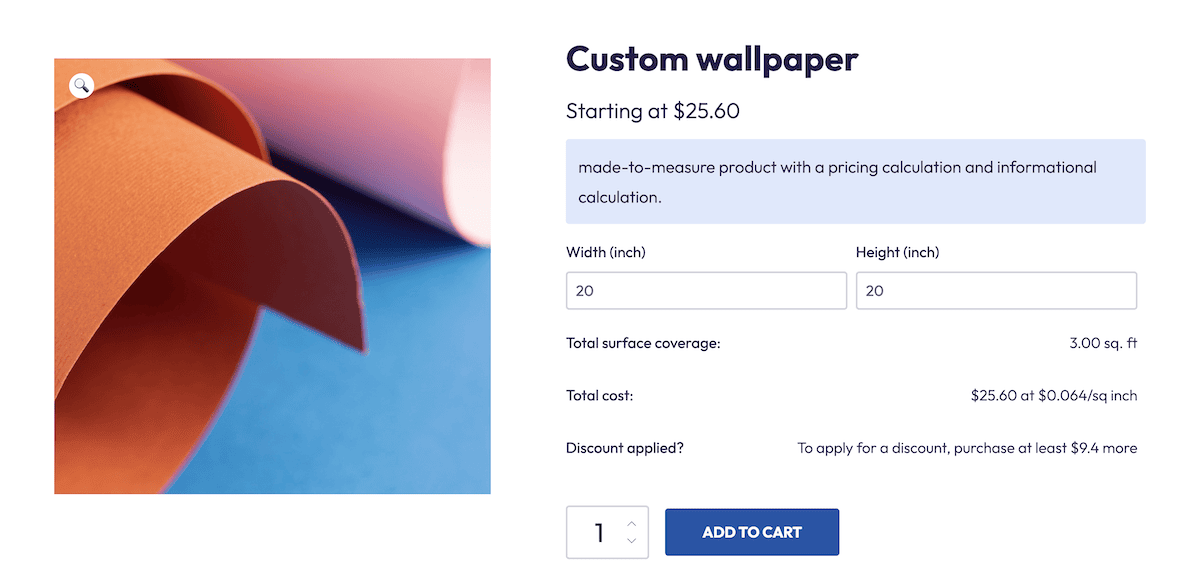
This comes from an experienced development team, but costs $149 per year, which is expensive. What’s more, it also has poor user ratings on the WooCommerce website.
If you want a visual, drag-and-drop interface, the Price Calculator for WooCommerce plugin could be for you.
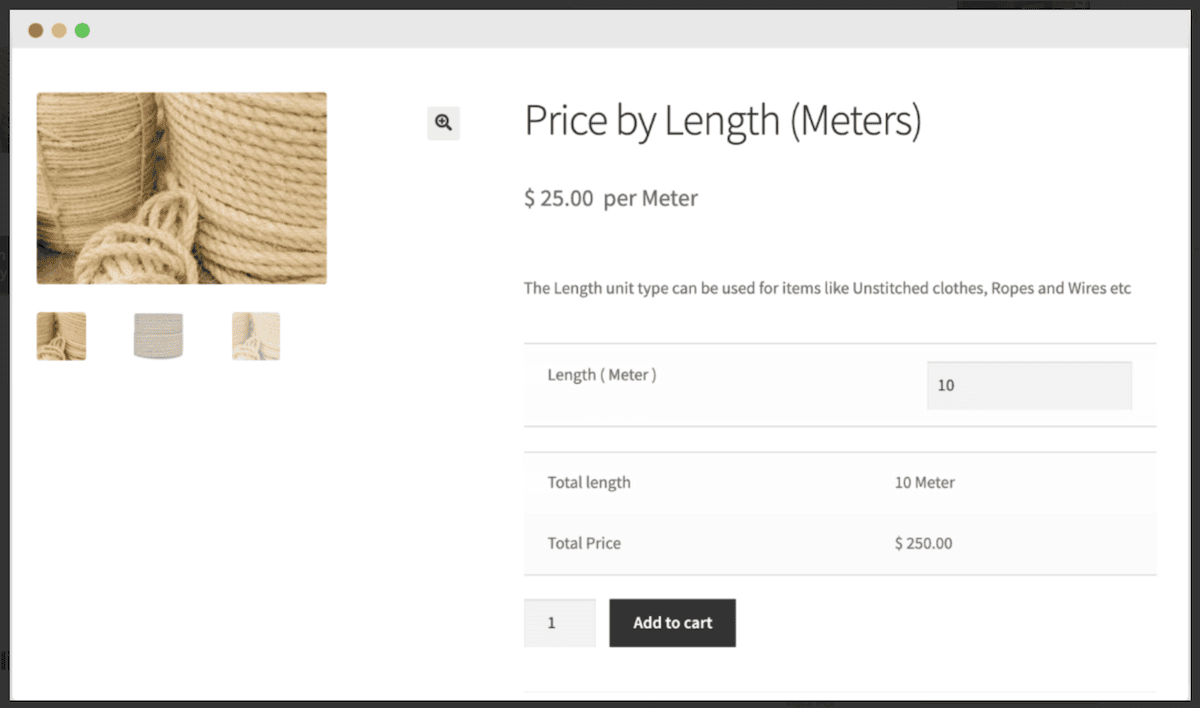
It supports various field types and conditional logic, and includes a multitude of measurement options. It costs $79 per year, and provides a straightforward way to add a price calculator to your site.
Introducing Advanced Product Fields for WooCommerce
Despite there being a number of plugin options available, none can offer the right blend of user satisfaction, cost-effective pricing, and flexible functionality of Advanced Product Fields for WooCommerce.

This powerful plugin lets you add extra options to your WooCommerce product pages and create complex pricing rules based on those additions. The plugin is an ideal tool for building price calculators—among many other use cases—without the need for extensive coding:
- You have a variety of field types, such as text, numbers, checkboxes, radio buttons, and more). There are even image swatches for better visual representation of your service options, and the ability to let customers upload documents through the front end.
- The plugin offers conditional logic to show or hide fields based on other values. For example, you could add a House Type field and only show a Number of Rooms field if the user selects the House option.
- There’s the ability to set complex pricing rules based on field values. For instance, if you offer discounts for longer commitments, those rules could adjust the price based on the signup duration.
The plugin’s formula-based pricing lets you implement intricate calculations, while its conditional logic enables you to create dynamic forms that adapt to user input. This combination of features can help you build a sophisticated WooCommerce price calculator for almost any purpose.
While there’s a free version of the plugin available, a premium license gives you much more functionality. A Pro license costs £55 per year for a single site.
How to build a WooCommerce price calculator using Advanced Product Fields for WooCommerce
Building a calculator with Advanced Product Fields for WooCommerce is a breeze. All you need is an active version of the plugin, and a little knowledge of how it works.
You’ll also want to choose or create a custom product within WooCommerce that you set as a Simple Product with a base price. Once you publish this product, you can begin to build your price calculator.
1. Add your calculator’s custom fields
With the product metaboxes on screen, you can start to add the custom fields that will make up your price calculator.
First, scroll down to the Custom Fields section, which the Advanced Product Fields plugin adds upon install:

Depending on whether your product already has a custom field, you’ll either see a Add your first field button, or an Add a field button at the bottom of this section:
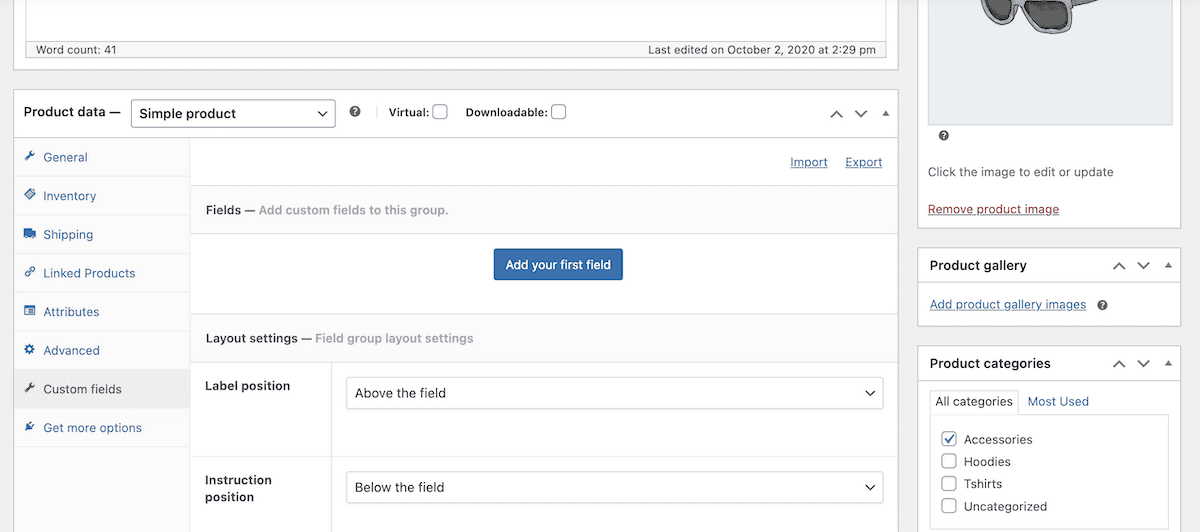
Regardless, enter a name for the field within the Label text box. For instance, create a Number of Rooms field as a Number type, and make sure you require it when a customer makes a calculation:
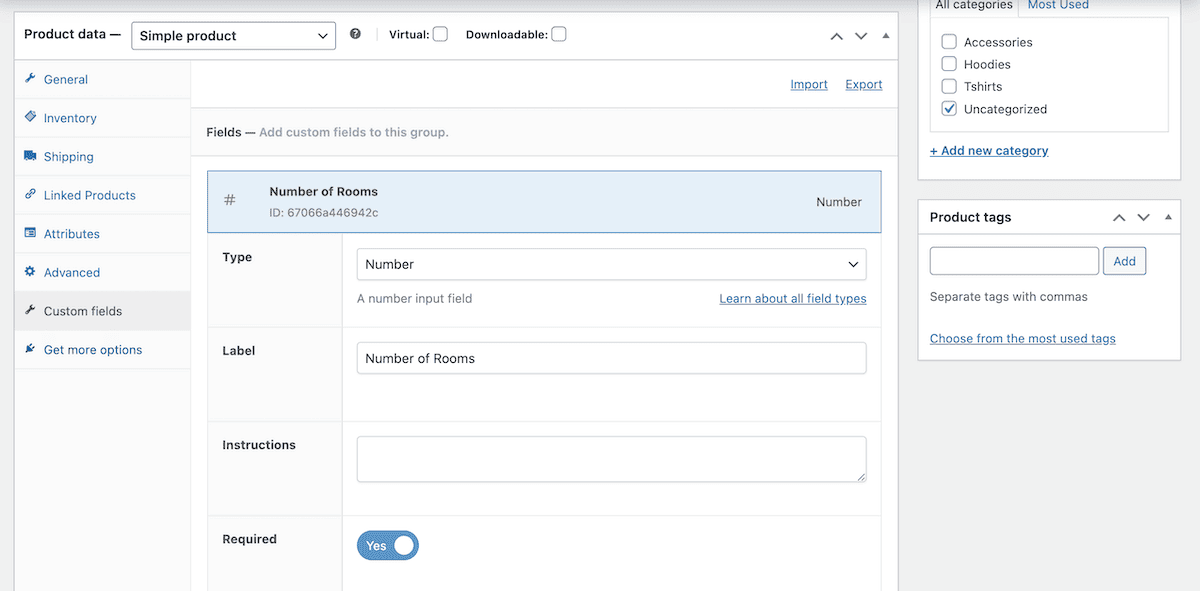
We’re also going to add a Cleaning Frequency field. This will be a Select list type. In the Options section, add relevant list items such as One-time, Weekly, and Monthly. Again, this should be a required field:
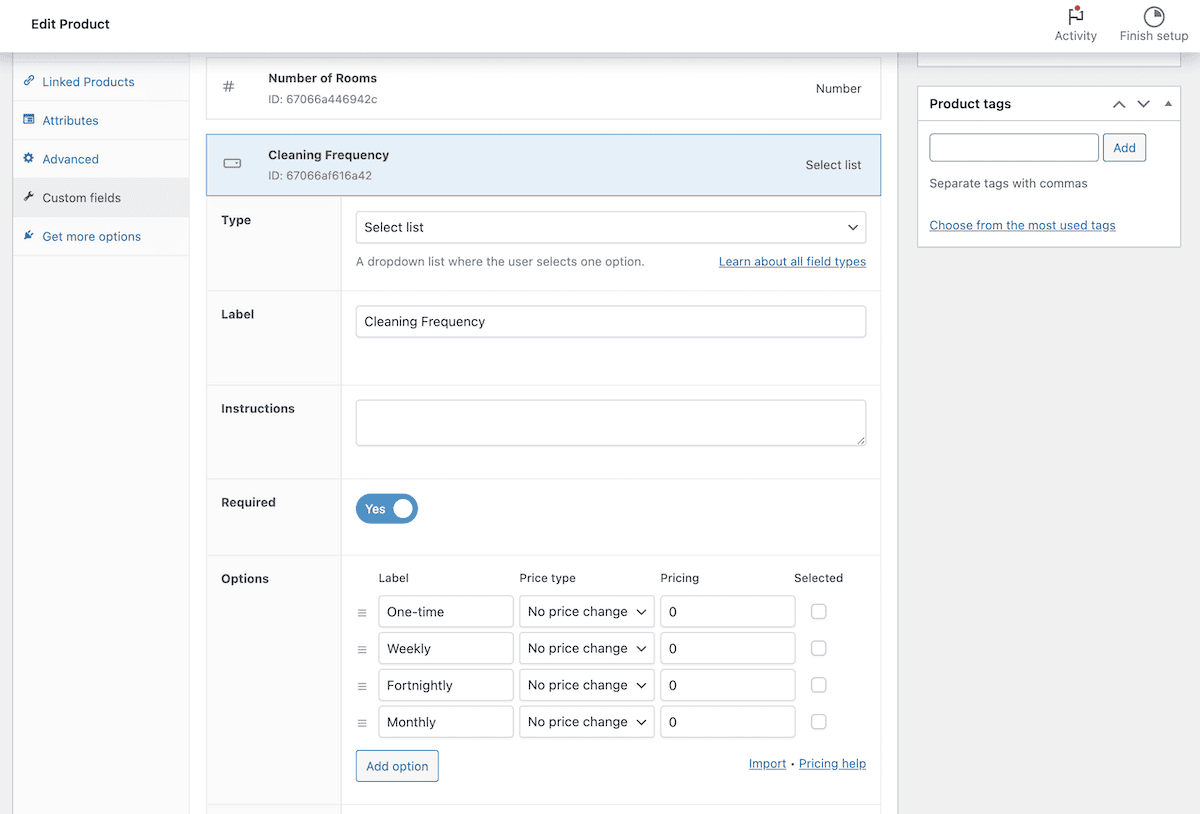
You can continue to add more fields relevant to your product or services. For example, we also have an Additional Services field that lets the customer select various extra cleaning options:
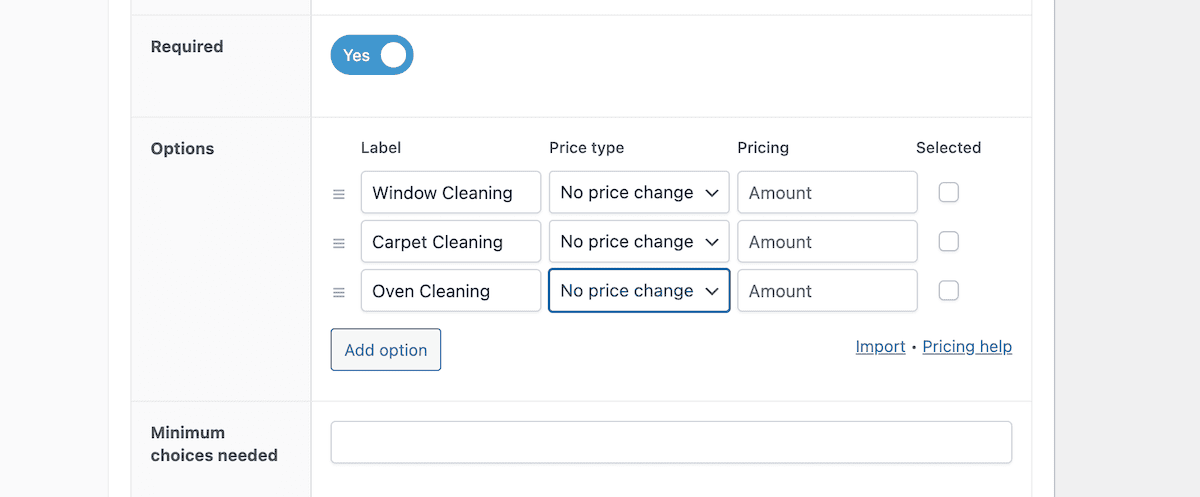
Once you save your changes, you can begin to work on the pricing for your product or service.
2. Set up your pricing rules
Of course, your pricing rules will be central to the whole WooCommerce price calculator. To work with your pricing, head to Custom Fields, find your field, and toggle the Adjust Pricing button:
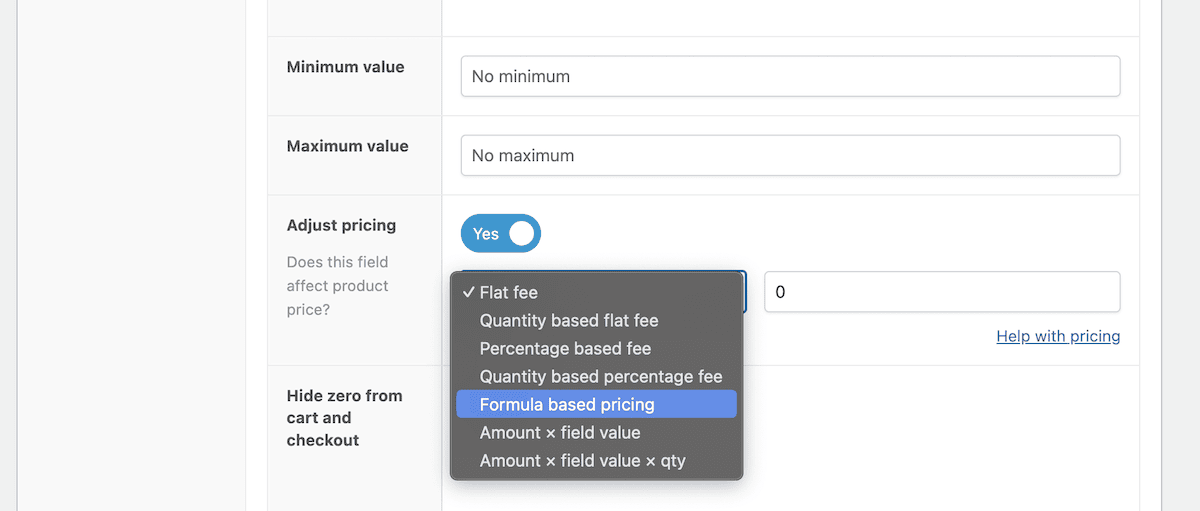
There are a few different options within the drop-down menu. Generally, this will be something you set based on the field and your own pricing model. For our Number of Rooms model, we’re going to create a formula that multiplies the base price by the number of rooms:
[price] * [field.67066a446942c]
You enter this within the Adjust Pricing section:
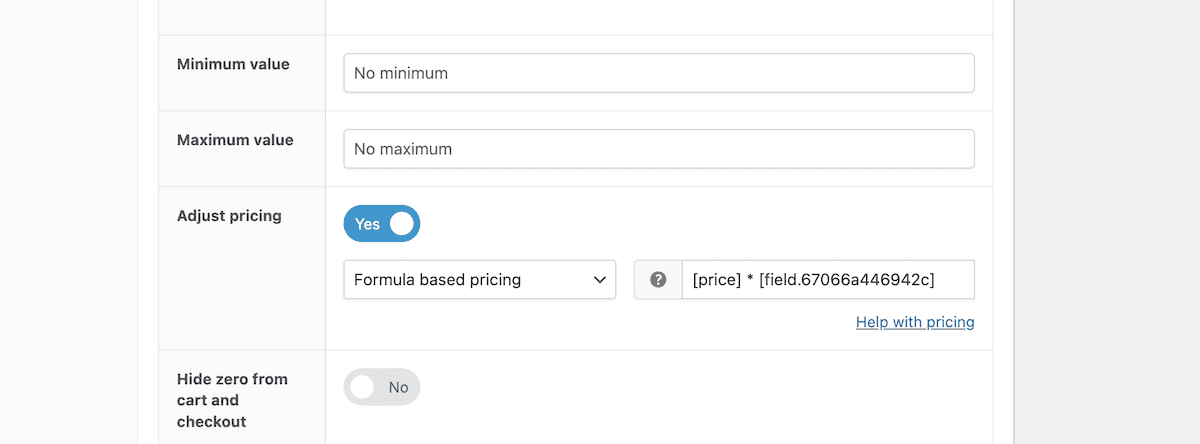
This formula essentially takes the regular price of the product and multiplies it by the value in Number of Rooms (represented here by the field ID). For our Cleaning Frequency, we can use formulas or flat fees depending on the service:
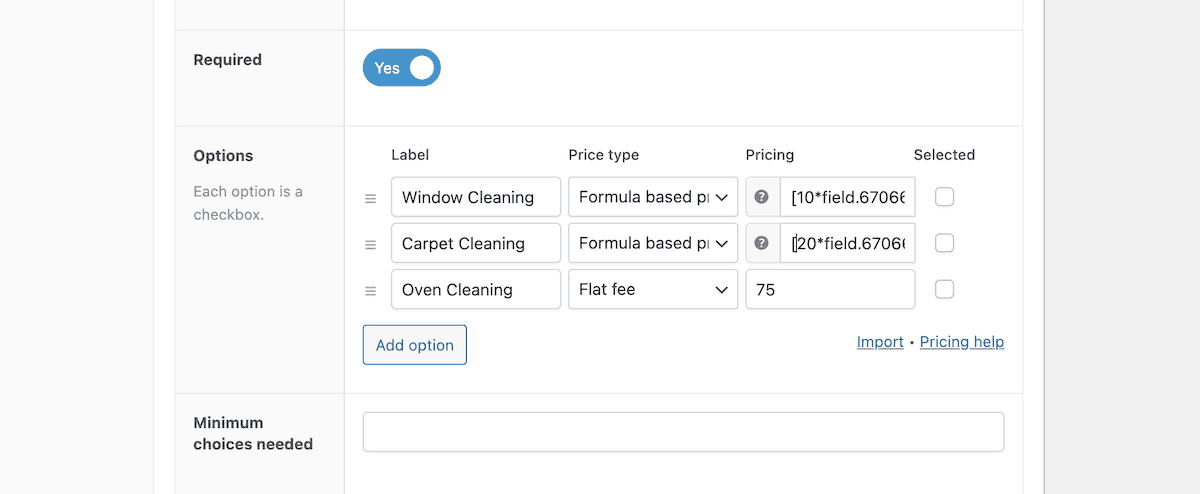
When it comes to the cleaning frequency, there are plenty of options to choose from. We’re going for a simple discount option using both formulas and percentages:

At this point, save your changes and test out the functionality on the front end. From here, you can make further tweaks and changes, and even style your fields using the options within WooCommerce.
Offer front-end pricing without the need for code using Advanced Product Fields for WooCommerce!
Building a price calculator for your WooCommerce store can significantly enhance its user experience, especially for products or services with variable pricing. Advanced Product Fields for WooCommerce lets you create sophisticated price calculators without extensive coding knowledge.
The plugin also offers the flexibility to handle a wide range of pricing scenarios, such as simple measurement-based calculations to complex service configurations. This means you can sell custom products, offer professional services, and more with Advanced Product Fields for WooCommerce as the backbone of your interactive and user-friendly pricing system.
What challenges do you envisage for your store, and how will a WooCommerce price calculator help? Share your thoughts in the comments section below!
